University of Wales Trinity Saint David
The Ungovernable Governess:The Figure of the Governess in the Victorian Sensation Novel of the 1860s.
 Get PDF
Get PDFThis dissertation will examine the figure of the governess in the Victorian Sensation Novels of the 1860s in order to determine if sensation fiction in this period was inevitably concerned with portraying the ungovernable side of femininity. The primary focus will be on the female protagonist in Mary Elizabeth Braddon’s Lady Audley’s Secret, Wilkie Collins Armadale, Louisa May Alcott’s ‘Behind a Mask,’ and Ellen Wood’s East Lynne.1 The effects of the moral and social climate of the nineteenth century and the influence the historical governess had on these works will be examined. The hypothesis that Braddon, Collins, Alcott, and Wood use the governess to depict various forms of female non-conformity in order to comment on the limitations and injustices of the woman’s position in a male dominated society will be considered, particularly in relation to the depiction of Victorian matrimony and the sexual double standard. Under discussion will be the liminal position of the governess and the way in which these villainous and deviant women use masquerade and their position in ways that tend towards deception. The motivation behind the actions of these transgressive females will also be discussed, particularly the significance of poverty and social position on their ungovernable behaviour, and the extent to which these texts and the governess figure can be seen as feminist will be explored.
Muslim religious experiences
 Get PDF
Get PDFThe purpose of this paper is to present and to encourage discussion of issues raised by
consideration of the topic of the Joint Annual Conference of the Modern Churchpeople’s
Union and the Alister Hardy Society 2004, The God Experience: who has it and why? from the
Muslim perspective. The presentation consists of four sections: beginning with an
introduction giving an overview of religious experience among the main Islamic sources of
knowledge about God, and also an overview of the Islamic concept of God in relation to
Muslim religious experience. The next section deals with the personal religious experience of
ordinary Muslims in the sense of non-mystics or non-Sufis. The third section deals with the
religious experience of Muslim mystics, namely, the Sufis, and the last section is concerned
with Muslim religious experience in an inter-faith context. Following a systematic description
of Sufi and Non-Sufi Muslim religious experiences, I argue that religious experience should
be encouraged more and more as a direct and personal source or support of faith in God in
our present time of suspicion, individualisation and outwardness
Ecological and mystical spirituality from an interfaith perspective
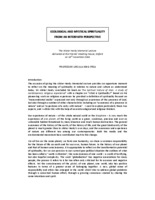 Get PDF
Get PDFMore than ten years ago, the Club of Rome published its much discussed report The First
Global Revolution which stressed that our world possesses a promising opportunity, one
unlikely to be provided again, to shape a new understanding and new attitudes towards the
world as a whole. Whilst contemporary societies are much confused about morals and
ethics, whilst we experience much social, educational, personal and environmental chaos,
the Club of Rome report argued that it is essential for humanity to respond to this unique
opportunity for a global revolution and find the wisdom needed to deal with it in the right
way. But how can we find such wisdom? How can we deal with our personal, social and
ecological predicaments? Traditionally, religions have fostered wisdom and morality, have
shaped individuals and groups, yet their teachings have shown few outward signs of success
because their loftiest ideals have rarely been put fully into practice.
For the Club of Rome to appeal to inherited wisdom was a momentous step; it was an
appeal to our global religious and philosophical heritage, but also to the task of analysing the
powers of spirituality for contemporary society and culture, and to discern the different
cultural and historical expressions of spirituality whilst assessing their significance for
contemporary ecological thinking and concerns. More recently, the American ecological
thinker Thomas Berry, much shaped by his deep knowledge of American native traditions, of
eastern religions, and the work of the French thinker Pierre Teilhard de Chardin, also spoke
about the need to draw on the resources of wisdom in his seminal book The Great Work.
Our Way into the Future. The great work, which is the work of all the people, is “to create a
mutually enhancing mode of human dwelling on the planet Earth”. Thomas Berry speaks of
the need to rediscover the spiritual sense of the universe and the need “to reinvent the
human”. To create a viable earth community, to develop the new world vision required for
building a viable human future, the politics, education and financial arrangements around
the globe – or governance, universities and corporations – need fundamental restructuring.
This task is impossible to achieve if humankind does not creatively draw on what Berry calls
the “four wisdoms”: 1. the wisdom of the classical traditions, that is to say the wisdom of
traditional religions and philosophies; 2. the wisdom of native peoples; 3. the wisdom of
women; 4. the much more recent and newer wisdom of science.
This is a profound insight, for we have so far little explored the spiritual resources of science
and nature. The convergence of traditional spiritual perspectives of a religious consciousness
with some of the spiritual insights that modern science yields is a truly exciting development
for human consciousness and community.
So how can we relate ecology, spirituality and our global religious heritage
A study of the Apostle Paul's approach to the law in Galatians chapters 2 and 3.
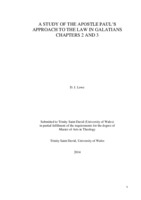 Get PDF
Get PDFThe need for this research grew out of the challenges faced by the writer in his involvement with Christian and Jewish perceptions of Paul and the impassioned response his writing on the law seemed to evoke.
This paper investigates Galatians chapters 2 and 3 in an attempt to derive a slightly different reading of Paul‟s treatment of the law to that which permeates traditional Christian and Jewish theology. It briefly assesses historical sensitivities that may well have provoked the defense of Jewish identity discernable in covenantal nomism, the very issues Paul was attempting to address for Gentile covenant membership in light of Christ. Confined to this challenge, he commits to expositing the law‟s purpose, drawing conclusions on works-righteousness, faith and the inevitable outcome for Christian Gentile conformity to Jewish covenantal obligations.
The paper assesses claims that Qumran had a works-righteousness policy representative of a universal Jewish system of works-righteousness, the significance of faith through the lens of Habakkuk 2:4, and Paul‟s attempt at expounding the law as the means of a „schoolmaster‟ until the advent of Christ.
The discussion confines the Galatian argument to that which was originally contended, the insistence on Gentile conformity to Jewish covenantal nomism and not the commonly held Pauline affront to Jewish law in an attempt to correct universal Jewish apostasy. This assists in helping to relieve Paul of the persona of him rejecting every element of his national heritage visible in his „alleged‟ polemic against the law
Contra Imperium : Biblical foundations of an anti-imperial theology.
 Get PDF
Get PDFThe current financial crisis, and the controversy surrounding equality legislation and conservative Christians, merits serious theological consideration. The anti-imperial interpretation of the New Testament is a relatively new discipline with roots in the slightly older tradition of liberation theology. It has frequently highlighted the disturbing parallels between the Western economy and the injustice of Babylon in its reading of Revelation. A response to this injustice has also been articulated in the last decade through the anti-imperial interpretation of Paul's letters by Richard A. Horsley and others. This dissertation partly seeks to assess the contribution of the anti-imperial interpretation of Revelation 13, 17 & 18, and 1 Corinthians, to understanding and responding to the financial crisis. Is its critique of the Western economy through Revelation accurate and justified, and is Horsley's anti-imperial vision an appropriate response? However, since anti-imperial scholars have not yet discussed the controversy surrounding the relationship between Christians and equality legislation, this dissertation also asks the question of whether their model can aid in understanding and responding to it as well. The model is partly vindicated by the grim fact that it reveals in both situations the characteristics of Babylon and the Beasts which lead to their destruction. Unfortunately, Richard Horsley's anti-imperial vision provides only a partial response to this recognition. The opposition of the Church to the unjust practices of surrounding society is clear in Paul's teaching. However, by not mentioning that Christ's love conditions this opposition, he allows for dangerous misappropriation. This is made particularly likely by the strong emotions the issues examined often evoke. To fill the gap in Horsley's vision, it is then compared with the relevant elements of Oliver O'Donovan's political theology. O'Donovan takes into account the conditioning influence of Christ's love, and so provides the foundation for a more biblically faithful response
Cynhaeaf:customs, practices and folklore associated with the traditional harvest in Wales
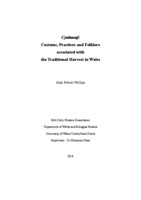 Get PDF
Get PDFThis thesis aims to explore a wide variety of customs and practices associated with the traditional harvest in Wales, principally during the nineteenth century; with a particular focus on south-west Wales, where the evidence survives most strongly. This includes an examination of the practice of harvest migration to destinations both within and outside Wales, the traditions associated with it, and the social stresses which it engendered; with particular attention to the practice of cyflog y groes, or cross wages, in the Vale of Clwyd. The customs and symbolism surrounding the last sheaf, or caseg fedi, are scrutinised in some detail, together with their long-standing Frazerian interpretation, and an alternative approach is proposed. An exploration of a range of harvest folklore demonstrates in particular the constant personification of sheaves as animals or people. The essay concludes by tracing the traditional supper at the end of harvest, the merrymaking associated with it, and the reasons for its eventual replacement by the Christian harvest festival. Throughout the study attention will be drawn to the social and ritual tensions accompanying these customs, including tensions in the harvest field, and the contrast between co-operation among farms on the one hand and aggressive competitiveness on the other; as well as the prevailing context of subsistence or borderline deprivation in which they take place
Seventy-four Christian experiences: a comparative study of experiences from four different traditions
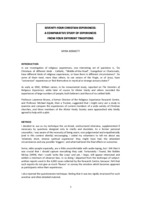 Get PDF
Get PDFIn our investigation of religious experiences, one interesting set of questions is, ‘Do
Christians of different kinds - Catholic, “Middle-of-the-Road”, Evangelical or Charismatic,
have different kinds of religious experiences, or have them in different circumstances? Do
some of them tend, more than others, to see visions of the Virgin, or of Jesus, have
“conversion” experiences or find themselves in mystical or strange sensory states?’. Professor Lawrence Brown, a former Director of the Religious Experience Research Centre,
and Professor Michael Argyle, then a Trustee, suggested that I might carry out a study to
examine and compare the experiences of current members of a wide variety of Christian
churches, and three members of the Alister Hardy Society were approached who kindly
agreed to help with a pilot. I decided to use as my technique the un-timed, unstructured interview, supplemented if
necessary by questions designed only to clarify and elucidate. As a former personal
counsellor, I was aware of the necessity of being warm, non-judgemental and empathetically
(and in this context silently) encouraging. I asked my volunteers to tell me about any
‘relatively short, intense spiritual experience’ they might have had, the attendant
circumstances and any possible ‘triggers’, and what had been the final effects or outcomes. To provide some quantitative data it was proposed to ask participants to rate aspects of
their experiences on a scale of 1 to 5
The Anatomy Lesson of Professor Moxham
 Get PDF
Get PDFThe study of anatomical structures that can be seen by unassisted vision, has long been a subject of fascination for artists. For most modern viewers, however, the anatomy lesson hardly seems the proper breeding ground for the hybrid workings of art and theory. We forget that, in its early stages, anatomy pursued the highly theatrical spirit of Renaissance science, as painters such as Rembrandt and Da Vinci shared audiences devoted to the workings of the human body. Anatomy Live, a remarkable consideration of new developments on the stage, as well as in contemporary writings of theorists such as Donna Haraway and Brian Massumi, turns our modern notions of the dissecting table on its head-using anatomical theatre as a means of obtaining a fresh perspective on representations of the body, conceptions of subjectivity, and own knowledge about science and the stage
A Modified Synthetic Aperture Focussing Technique Utilising the Spatial Impulse Response of the Ultrasound Transducer
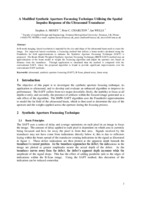 Get PDF
Get PDFIn B-mode imaging, lateral resolution is impeded by the size and shape of the ultrasound beam used to create the image. For improved lateral resolution, a focussing method that utilises a beam model calculated using the Fraunhofer far field approximations to enhance the Synthetic Aperture Focussing Technique (SAFT) is proposed. The Beam Model Weighted Synthetic Aperture Focussing Technique (BMW-SAFT) method uses an approximation of the beam model to weight the focussing algorithm and adjust the aperture size based on distance from the transducer. Through application to simulated data the method is compared with the conventional SAFT, where the proposed algorithm is found to provide significant improvements over the conventional SAFT methods
Re-Evaluation of RF Electromagnetic Communication in Underwater Sensor Networks
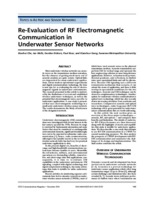 Get PDF
Get PDFMost underwater wireless networks use acoustic
waves as the transmission medium nowadays,
but the chances of getting much more out of
acoustic modems are quite remote. Optical links
are impractical for many underwater applications.
Given modern operational requirements
and digital communications technology, the time
is now ripe for re-evaluating the role of electromagnetic
signals in underwater environments.
The research presented in this article is motivated
by the limitations of current and established
wireless underwater techniques, as well as the
potential that electromagnetic waves can offer to
underwater applications. A case study is presented
that uses electromagnetic technology in a
small-scale underwater wireless sensor network.
The results demonstrate the likely effectiveness
of the designated network